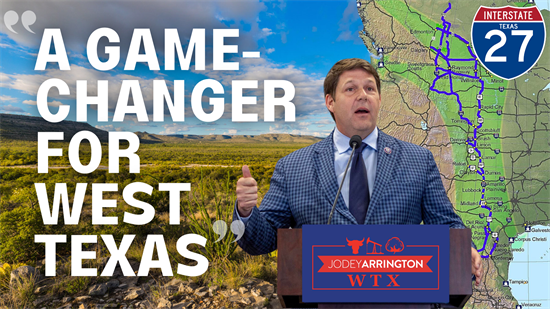Arrington Celebrates His Legislation to Name Ports-to-Plains Corridor “I-27” Being Signed into Law
 Chairman Jodey Arrington (TX-19) celebrated his bipartisan legislation to rename the interstate-designated segments of the Ports-to-Plains Corridor to “I-27.” This legislation being signed into law marks an important step in the project that connects the ports of South Texas to the plains of West Texas and beyond, stimulating substantial economic growth and providing a competitive edge to producers and manufacturers throughout the region.
Chairman Jodey Arrington (TX-19) celebrated his bipartisan legislation to rename the interstate-designated segments of the Ports-to-Plains Corridor to “I-27.” This legislation being signed into law marks an important step in the project that connects the ports of South Texas to the plains of West Texas and beyond, stimulating substantial economic growth and providing a competitive edge to producers and manufacturers throughout the region.
“The I-27 Ports-to-Plains Corridor will be a game-changer for West Texas and America’s Heartland,” said Chairman Arrington. “I am proud to have led this important bipartisan legislation and thank my colleagues on both sides of the aisle for their efforts. Together, we have enhanced the future of rural America and strengthened our nation’s food security and energy dominance.”
In 2022, Chairman Arrington ushered into law his legislation to designate the portion of the Ports-to-Plains Corridor from Laredo, Texas, through the Panhandle to Dumas, Texas, as a future interstate route, making it eligible for federal funding.
The expansion of the I-27 corridor is critical to linking the energy and agricultural industries to state, national, and international trade, and it is estimated to grow Texas’s Gross Domestic Product (GDP) by over $55.6 billion in the first 20 years, create 178,600 construction jobs, and add 17,000 long-term employment opportunities.
The 2,300 mile Ports-to-Plains Corridor “I-27”:
- Extends from Mexico to Canada through eight states in America’s Heartland. It is part of the National Highway System, which makes up about five percent of the nation’s roads, yet it carries over 55 percent of the vehicle miles traveled.
- Is an energy corridor serving traditional resources like oil and gas as well as renewable resources like wind, solar, and biofuels. Development of these resources is critical to our energy security, providing a stable and more affordable power source. The Ports-to-Plains Alliance Corridor serves the, Bakken, Niobrara, Permian Basin, Cline, Eagle Ford, emerging Mexico energy shale plays, and the oils sands in Alberta.
- Is an agriculture corridor running through four of the top eight farming states. It moves agriculture products from the Ports-to-Plains regions to urban domestic markets, to export markets on the coast, and on the Canadian and Mexican borders.
- Is an international trade corridor serving major international border crossings connecting Texas to Mexico and connecting Montana and North Dakota to Canada.
- Is a connectivity and economic development corridor running through and connecting small towns and rural communities in America’s Heartland. To unleash America’s economy, create millions of new jobs, and boost economic growth, it is essential to connect these small towns and rural areas to the 21st century economy. Moreover, a modern, four-lane divided highway will improve safety through the Corridor.
- Is a cost-effective way to reduce congestion on Interstate-25 and Interstate-35. It runs north-south between two highly congested, north-south interstate highway corridors – I-35 to the east and I-25 to the west. The Ports-to-Plains Alliance Corridor can be a cost-effective part of the solution. Upgrading the Corridor to a modern four-lane, divided facility would cost a small fraction of the cost of improvements to I-25 and I-35. Once upgraded, a significant number of trucks are likely to divert to the Ports-to-Plains Corridor rather than sitting in congestion on I-25 or I-35, thereby providing congestion relief on these routes. Improved on-time delivery and decreased transportation costs for goods and services will be the result.



